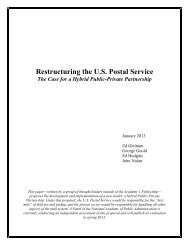High-Performance Partnerships - National Academy of Public ...
High-Performance Partnerships - National Academy of Public ...
High-Performance Partnerships - National Academy of Public ...
Create successful ePaper yourself
Turn your PDF publications into a flip-book with our unique Google optimized e-Paper software.
PERFORMANCE MANAGEMENT<br />
GLOSSARY OF TERMS<br />
appendix C<br />
PERFORMANCE MANAGEMENT<br />
GLOSSARY OF TERMS 8<br />
Activity Measures: Provide information on workload/volume <strong>of</strong> business (e.g., number <strong>of</strong> applications<br />
processed).<br />
Balanced Scorecard: A management instrument that translates an organization’s mission and<br />
strategy into a comprehensive set <strong>of</strong> performance measures to provide a framework for strategic<br />
measures and management. The scorecard measures organizational performance across several<br />
perspectives: financial, customers, international business processes, and learning and growth.<br />
Baseline: A set <strong>of</strong> data used as a base to measure the impact <strong>of</strong> changes over time.<br />
Benchmarking: The process <strong>of</strong> continuously comparing and measuring performance against others<br />
in order to gain information that will help take action to improve performance.<br />
Customer: The person or group that receives or uses government services, or the person or entity<br />
directly served by the county.<br />
Cost-effectiveness: Minimizing the cost <strong>of</strong> achieving an intended result through a certain strategy.<br />
Cost-efficiency: Minimizing the cost per unit <strong>of</strong> good/service produced.<br />
Efficiency Measures: Indicators that measure the cost, unit cost, or productivity associated with a<br />
given outcome or output. They provide information on how well the organization used its<br />
resources to produce certain goods and services (e.g., cost per operation, cost per applicant).<br />
Goals: The general ends toward which agencies or departments direct their efforts. A goal addresses<br />
issues by stating policy intention.<br />
Inputs: The resources that a county uses to produce services, including human, financial, facility,<br />
or material resources (e.g., number <strong>of</strong> dollars expended or tons <strong>of</strong> material used).<br />
Intermediate Outcome Measures: Provide short-term “markers/indicators” <strong>of</strong> progress towards a<br />
longer-term outcome.<br />
Mission: An enduring statement <strong>of</strong> purpose; the county or department’s reason for existence. The<br />
mission describes what the county or department does, who it does it for, and how it does it.<br />
Objectives: Clear targets for specific action. More detailed than goals, objectives have shorter time<br />
frames and may state quantity.<br />
8 These definitions are taken largely from the glossary published by the <strong>National</strong> Association <strong>of</strong> Counties at<br />
www.naco.org/research/issues/perf_tool.cfm<br />
144 Powering the Future: <strong>High</strong>-<strong>Performance</strong> <strong>Partnerships</strong>









